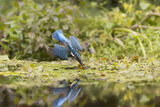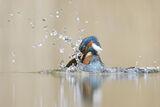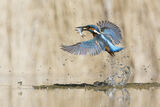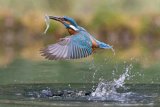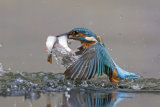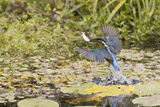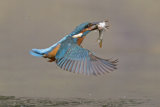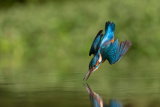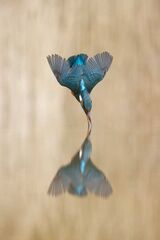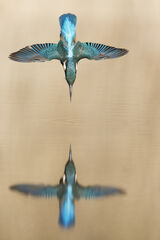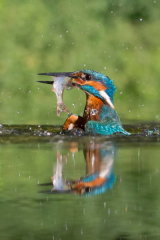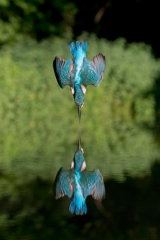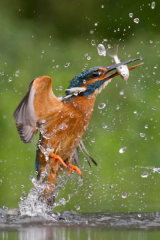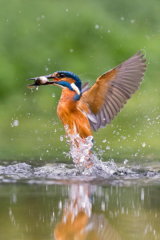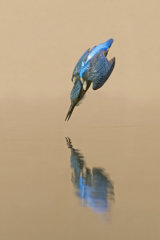Kingfisher Diving
Kingfisher diving.
Suffolk.
There are certain images that have that 'Wow factor'. If, like me, you have marvelled at photos that depict action captured in a split second on camera then this may be the workshop for you.
I have created a natural looking set for the sole purpose of obtaining images of kingfishers fishing. Once I have positioned your camera you should be able to obtain shots of the birds entering and exiting the water. Every dive is different and therefore your images will have a variety of poses.
Everything has been done to make these difficult to obtain action shots reasonably easy to achieve on the day.
Cost of Kingfisher Diving workshop
Full day (approx 7.30 am - 3 pm) £200 per person.
Equipment: The set up is a raised pool. The cameras are positioned at one end and auto-focused on the point where the bird enters the water. Switch over to manual focusing to fix the lens at this focus. The camera is fired by a wireless remote from the comfort of the hide around 30 feet away.
For kingfisher diving the following equipment is essential.
1. A tripod.
2. Focal length around 200mm. eg. for Canon users the ideal would be 100 – 400 or 70 - 200 f 2.8.
3. Wireless remote release with ability to change channel on transmitter and receiver. Minimum range 30 feet. (sounds obvious but make sure it is compatible with your camera). This must work from all directions and not just facing the camera. OR 10 meters extension shutter cable.
4. To ensure a decent hit rate a camera with at least 6 frames a second is best. Buffer of at least 10 frames. Minimum 1/4000th second capability.
5. The action is extremely fast and you must be accepting that conditions may dictate high ISO. For birds entering the water perhaps up to ISO 6400 if the conditions are not bright. The best shots in my opinion are of the exiting bird. Thankfully they are much slower at this point and it is possible to capture sharp images at around 1/1500th-1/2000th second therefore lessening the need for such high ISO. You will also waste lots of images. My test shots have a bird in them around 50% of the time and most of these it is not in a perfect position. Hopefully most dives will result in at least one usable image and with around 30 dives predicted per session you should be left with plenty of keepers. (this prediction is based on the behaviour of the birds last brood and is by no means guaranteed)
Ethics. There has recently been some debate regarding the ethics concerning baiting and kingfisher photography.
The first point is the safety of the bird. One method commonly used to direct the kingfisher to the spot you wish it to dive is to submerge a glass tank. Whilst I am not aware of any occurrences with the bird entering from the side and hitting the glass I accept this is a possibility so have designed my method to eliminate this risk. My container is padded and can only be entered from directly above thus ensuring the safety of the bird at all times.
The second and perhaps more contentious issue relates to the use of live bait. There is no way around this, kingfishers eat fish! My fish are sourced either from a fish farm or fishing lakes that are so heavily over stocked if I wasn’t using the fish for feeding kingfishers they would be removed and left to die on the lake bank. Every fish that is provided by myself means the birds take one less from the river.
Suffolk.
There are certain images that have that 'Wow factor'. If, like me, you have marvelled at photos that depict action captured in a split second on camera then this may be the workshop for you.
I have created a natural looking set for the sole purpose of obtaining images of kingfishers fishing. Once I have positioned your camera you should be able to obtain shots of the birds entering and exiting the water. Every dive is different and therefore your images will have a variety of poses.
Everything has been done to make these difficult to obtain action shots reasonably easy to achieve on the day.
Cost of Kingfisher Diving workshop
Full day (approx 7.30 am - 3 pm) £200 per person.
Equipment: The set up is a raised pool. The cameras are positioned at one end and auto-focused on the point where the bird enters the water. Switch over to manual focusing to fix the lens at this focus. The camera is fired by a wireless remote from the comfort of the hide around 30 feet away.
For kingfisher diving the following equipment is essential.
1. A tripod.
2. Focal length around 200mm. eg. for Canon users the ideal would be 100 – 400 or 70 - 200 f 2.8.
3. Wireless remote release with ability to change channel on transmitter and receiver. Minimum range 30 feet. (sounds obvious but make sure it is compatible with your camera). This must work from all directions and not just facing the camera. OR 10 meters extension shutter cable.
4. To ensure a decent hit rate a camera with at least 6 frames a second is best. Buffer of at least 10 frames. Minimum 1/4000th second capability.
5. The action is extremely fast and you must be accepting that conditions may dictate high ISO. For birds entering the water perhaps up to ISO 6400 if the conditions are not bright. The best shots in my opinion are of the exiting bird. Thankfully they are much slower at this point and it is possible to capture sharp images at around 1/1500th-1/2000th second therefore lessening the need for such high ISO. You will also waste lots of images. My test shots have a bird in them around 50% of the time and most of these it is not in a perfect position. Hopefully most dives will result in at least one usable image and with around 30 dives predicted per session you should be left with plenty of keepers. (this prediction is based on the behaviour of the birds last brood and is by no means guaranteed)
Ethics. There has recently been some debate regarding the ethics concerning baiting and kingfisher photography.
The first point is the safety of the bird. One method commonly used to direct the kingfisher to the spot you wish it to dive is to submerge a glass tank. Whilst I am not aware of any occurrences with the bird entering from the side and hitting the glass I accept this is a possibility so have designed my method to eliminate this risk. My container is padded and can only be entered from directly above thus ensuring the safety of the bird at all times.
The second and perhaps more contentious issue relates to the use of live bait. There is no way around this, kingfishers eat fish! My fish are sourced either from a fish farm or fishing lakes that are so heavily over stocked if I wasn’t using the fish for feeding kingfishers they would be removed and left to die on the lake bank. Every fish that is provided by myself means the birds take one less from the river.

